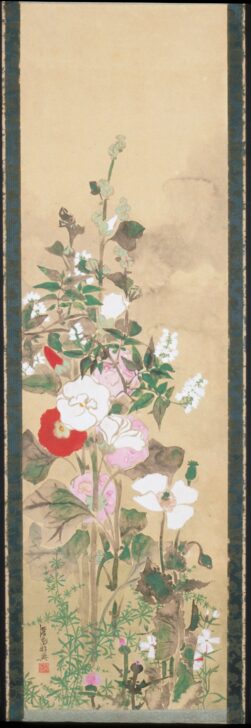Flowers and Grasses
Watanabe Shikō

Description
Gallery Rotations Fall 2012
Watanabe Shikô
Japan, 1683–1755
Flowers and Grasses
Edo period (1615–1868)
First half of 18th century
Hanging scroll, ink and color on paper
Museum purchase made possible by the Margaret Watson Parker Art Collection Fund, 1964/2.65
Watanabe Shikô rose to fame after he began to work for the aristocratic Konoe family in Kyoto. In 1735, he was commissioned to paint paneled screens for the imperial palace in Kyoto, and walls, ema (pictoral offerings), and fusuma (sliding doors) for various shrines and temples in the capital, Edo (modern Tokyo). Shikô’s style combines the precepts of the Kanô school, the official painting school of the ruling warrior class, and the Rimpa school, which was mainly patronized by the merchant class, making for a wonderful amalgamation of the traditional and the novel. Shikô’s work is known for expertly fusing realism and lively, arresting brushstrokes in vivid colors. In Flowers and Grasses the flowers, boldly painted in sumptuous reds and playful pinks, seem to jump out toward the viewer.
Subject Matter:
Painted in a way that combines precepts of the Kanô school with those of the Rimpa school making this style of work appealing to both the warrior/ruling class and the merchant class.
Physical Description:
Realistic flowers and grasses, painted with vivid colors on a hanging scroll.
Usage Rights:
If you are interested in using an image for a publication, please visit https://umma.umich.edu/request-image/ for more information and to fill out the online Image Rights and Reproductions Request Form.